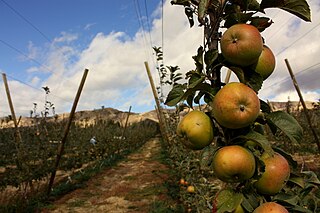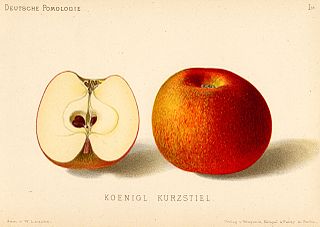
Cox's Orange Pippin, in Britain often referred to simply as Cox, is an apple cultivar first grown in 1825, at Colnbrook in Buckinghamshire, England, by the retired brewer and horticulturist Richard Cox. Though the parentage of the cultivar is unknown, Ribston Pippin seems a likely candidate. DNA analysis of major apple pedigrees has suggested Margil as the parent of Cox, with Ribston Pippin being another Margil seedling. The variety was introduced for sale by the 1850s by Charles Turner, and grown commercially from the 1860s, particularly in the Vale of Evesham in Worcestershire, and later in Kent. A paper by Howard et al seems to suggest that the Cox Orange Pippin is a hybrid between the Cultivars: Rosemary Russet and Margil based on the SNP data 7

A cooking apple or culinary apple is an apple that is used primarily for cooking, as opposed to a dessert apple, which is eaten raw. Cooking apples are generally larger, and can be tarter than dessert varieties. Some varieties have a firm flesh that does not break down much when cooked. Culinary varieties with a high acid content produce froth when cooked, which is desirable for some recipes. Britain grows a large range of apples specifically for cooking. Worldwide, dual-purpose varieties are more widely grown.

Russet apples are varieties and cultivars of apples that regularly exhibit russeting, partial or complete coverage with rough patches of greenish-brown to yellowish-brown colour. While russeting is generally an undesirable trait in modern cultivars, russet varieties are often seen as more traditional, and associated with aromatic flavours.

The 'Roxbury Russet' is an apple cultivar, believed to be the oldest apple cultivar bred in the United States, having first been discovered and named in the mid-17th century in the former Town of Roxbury, part of the Massachusetts Bay Colony southwest of Boston. It is known by several other names including 'Boston Russet', 'Putnam Russet', and 'Sylvan Russet'.

Reinette, often Rennet in English, and popular in Italian and Portuguese cuisines as Renetta and Reineta respectively, is the name of a number of apple cultivars.

Blenheim Orange (Kempster's Pippin) is a cultivar of apple. It was found at Woodstock, Oxfordshire near Blenheim in England in about 1740. It has been described as a cooking apple.

Esopus Spitzenburg or Aesopus Spitzenburgh is a variety of apple. It was discovered early in the 18th century near Esopus, Hudson, New York and is reputed to have been a favorite apple of Thomas Jefferson, who planted several of the trees at Monticello.

'Ribston Pippin' is a triploid cultivar of apples, also known by other names including 'Essex Pippin', 'Beautiful Pippin', 'Formosa', 'Glory of York', 'Ribstone', 'Rockhill's Russet', 'Travers', and 'Travers's Reinette'.

A pearmain, also formerly spelled "permain", is a type of apple. The name may once have been applied to a particular variety of apple that kept well, although in more modern times its inclusion in varietal names was, like the term 'Pippin', "largely decoration" rather than indicating any shared qualities.

The Newtown Pippin, also known as Albemarle Pippin, is an American apple that originated in the late 17th or early 18th century and is still cultivated on a small scale. At one time, there were two very similar apple cultivars known as the 'Yellow Newtown' and 'Green Newtown', one of which perhaps originated as a sport of the other.

'Adams Pearmain', also called 'Adam's Parmane', is a cultivar of apple. It was introduced to the Horticultural Society of London in 1826 by Robert Adams, under the name 'Norfolk Pippin'. The fruit is large, varying from two and a half inches to three inches high, and about the same in breadth at the widest part. It is pearmain-shaped, very even, and regularly formed. The skin is pale yellow tinged with green, and covered with delicate russet on the shaded side; but deep yellow tinged with red, and delicately streaked with livelier red on the side facing the sun. The flesh is reddish, crisp, juicy, rich, and sugary, with an agreeable and pleasantly perfumed flavor. This Cultivar is a sibling of Reinette de Hollande, a hybrid between Reinette Franche’ and ‘Reinette des Carmes. (5)
Table apples are a group of apple cultivars grown for eating raw as opposed to cooking or cidermaking. Table apples are usually sweet and the most prized exhibit particular aroma variations that differentiate them from other apples. D = Dual purpose

An apple is a round, edible fruit produced by an apple tree. Apple trees are cultivated worldwide and are the most widely grown species in the genus Malus. The tree originated in Central Asia, where its wild ancestor, Malus sieversii, is still found. Apples have been grown for thousands of years in Eurasia and were introduced to North America by European colonists. Apples have religious and mythological significance in many cultures, including Norse, Greek, and European Christian tradition.

Bismarck is an apple cultivar. The fruit from the tree is used for cooking due to its sharp flavour and is most commonly pureed when cooking.

'Allington Pippin' is an English cultivar of domesticated apple, with a strong flavour that includes hints of pineapple.

King of the Pippins or Reine des Reinettes (French), Goldparmäne, Wintergoldparmäne german is an old cultivar of domesticated apple originating from France, and is still used in its original form as well as in many derivative cultivars that have been bred from it. It was also formerly known as Golden Winter Pearmain, because of its ripening period at late fall.

'Duchess of Oldenburg' is an old Russian cultivar (1750–1799) of cultivated apple which has attractive streaks of yellow and red. It was commonly but not universally known in America simply as 'Oldenburg' after the American Pomological Society listed that as the official name, a name also used for the 'Geheimrat Dr. Oldenburg' cultivar. The skin of the apple is more prominently striped than that of 'Geheimrat Dr. Oldenburg'.

Golden Russet is an old American cultivar of domesticated apple which is excellent for fresh eating as well as for apple cider production. It is a russet apple and is therefore especially used as a cider apple. It is sometimes known as 'English Golden Russet', and has frequently been confused with 'English Russet'.

Court Pendu Plat is an extremely old French cultivar of domesticated apple that was first recorded in 1613. The cultivar definitely dates back to earlier than the 17th century, and was probably cultivated by the Romans. It is known for its intense flavor which mellows with storage.

Red Astrachan is a cultivar of domesticated apple of either Russian or Swedish origin, which is an early season apple, juicy, tart and mealy texture with pleasant flavour, and use for eating, cooking and cider. It is medium-sized, crimson colored. As all the early season apples, it is not good for storage. It is known by several other names including 'Abe Lincoln', 'American Red', and 'Waterloo'.



















